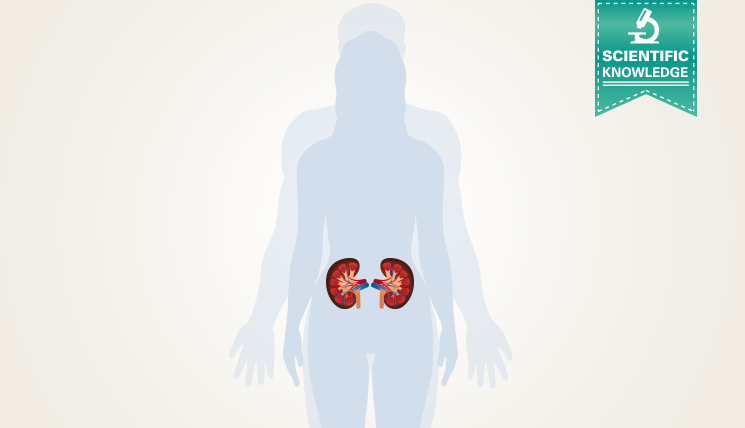Uromodulin is a kidney-specific glycoprotein, which is exclusively expressed by the epithelial cells of the ascending limb of loop of Henle (TAL cells) and secreted into the urine. There, it is the quantitatively most significant protein. Additionally, secretion of small quantities of uromodulin into the interstitium was described. In this way the proteins gets into the bloodstream [1, 2]. Uromodulin is described to have several functions. For example, it is supposed to play a vital role in the homoeostasis of water and electrolytes in the Henle loop. Moreover, there are signs that uromodulin helps to prevent kidney stones and urinary tract infections [3, 4].
Uromodulin became known as Tamm-Horsfall protein in the 1950ies already, but has not gained much attention until mutations in the coding UMOD gene were discovered in the last years which are linked to a number of autosomal dominant kidney disorders [3, 4]. In genome-wide association studies, also polymorphisms in the UMOD locus were identified, which are associated with kidney function and the development of chronic kidney diseases, as well as with the level of urinary uromodulin [5, 6, 7]. The concentration of uromodulin in urine is since then considered a new biomarker for kidney health.
The exact determination of uromodulin levels in urine however is hindered by the fact that the protein polymerises depending on the physiological conditions in the urine. Due to the variable degree of polymerisation and the lack of standardised methods for the preparation of urine samples, strong deviations may occur between the measured concentrations. Therefore, the linearity and reproducibility of the measurement results which are required if used for diagnostic purposes cannot be guaranteed.
In serum however, uromodulin does not produce polymers. Consequently, the concentration of the protein serum is much more suitable for the usage as possible diagnostic marker than the concentration in urine. Swiss authors of a current study report already that the serum concentration of uromodulin of the investigated patients decreased with increasing loss of kidney function [9].
Kidney function is typically defined by the glomerular filtration rate (GFR), the volume of liquid which is filtered per time unit by the glomeruli (ml/min). The GFR can be assessed by means of the so-called cleareance of specific marker proteins like creatinine. It shows how quickly the kidney can filter creatinine from the blood. Plasma concentration of creatinine, the volume of collected 24 hour-urine and the contained amount of creatinine are required for this measurement. A decreasing kidney performance manifests itself in a decreased creatinine clearance and thus a reduced GFR.
Alternatively, the GFR may also be estimated (eGFR) using mathematical formulas, based on the serum concentration of creatinine and the additional marker cystatin C. In this way, the time-consuming collection of 24 hour-urine is not required. Both proteins are of small size so that the kidney can filter them from the serum without any problem. Their serum concentrations increase with decreasing GFR. However, particularly creatinine has the disadvantage that the level in serum does not increase until the GFR is already clearly reduced. Within the creatinine-blind area, early stages of chronic kidney disorders which are often still free of symptoms cannot be detected by solely using the creatinine level. In addition, creatinine concentration can be influenced by external factors, like muscle mass and the patient’s diet, which can lead to inaccuracies in the calculation and thus hinders interpretation of the results.
This is not valid for serum concentrations of uromodulin: It decreases with diminishing kidney health (eGFR) and is already severely reduced in the early stages of kidney insufficiency, possibly due to the reduced number of functional, uromodulin-expressing epithelial cells in the loop of Henle. The protein quantities in serum are also independent of external factors. Conversion of the measurement results is not required [10]. Currently, it is investigated whether the uromodulin level in serum does also correlate with the therapy course and reflect the functionality of a kidney transplant.
A standardised ELISA for the determination of uromodulin concentrations in serum samples is already available for diagnostic purposes. As a supplement to creatinine, uromodulin can now be used as a sensitive marker for the determination of beginning kidney damage, as it may occur in the context of several diseases, for example chronic kidney failure, autoimmune diseases (systemic lupus erythematosus, membranous nephropathy, Goodpasture syndrome) or diabetes and high blood pressure.
[1] Jennings P, et al., J Am Soc Nephrol 2007, 18(1): 264-273. [2] Lhotta K, Kidney Blood Press Res 2010, 33: 393-398. [3] Rampoldi L, et al., Kidney International 2011, 80: 338-347. [4] Bleyer AJ, et al., Nephron Clin Prac 2011, 118: c31-c36. [5] Koettgen A, et al., Nat Genet 2009, 41(6): 712-717. [6] Koettgen A, et al., J Am Soc Nephrol 2010, 21: 337-344. [7] Olden M, et al., J Am Soc Nephrol 2014, 25(8): 1869-1882 [8] Youhanna S, et al., Nephrol Dial Transplant 2013, 0: 1-10. [9] Risch L, et al., Clin Chem Lab Med 2014, 52(12): 1755-1761. [10] Scherberich JE, et al., Abstract contribution to „Symposium Biomarker der kardiorenalen Achse“ 2015, Mannheim.

